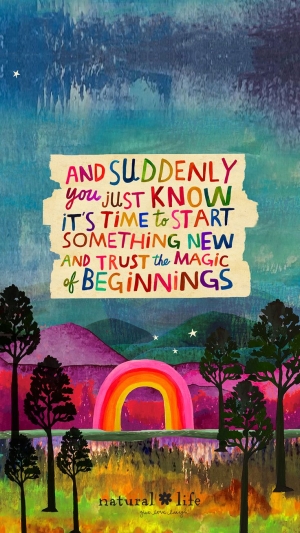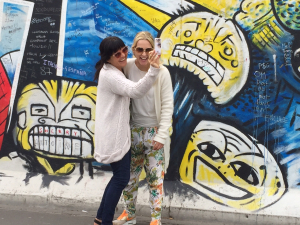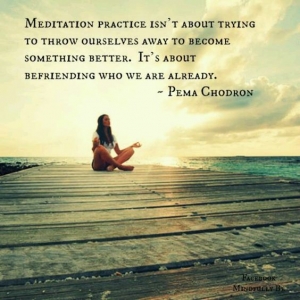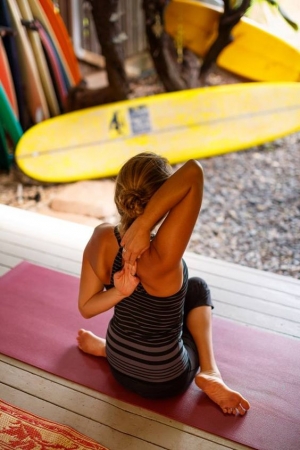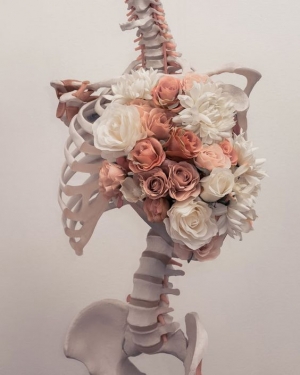
Displaying items by tag: self healing
The Magic of Beginnings
How Mental Healing Can Still Flourish in the Midst of COVID-19
By Breanna Pereira, NASM-Certified Personal Trainer and NASM-Certified Nutrition Coach - May 2020
How fitting that the anniversary of the acceptance of my depression would fall around Mental Health Awareness Month. Last year, I had paid no attention to it; this year, I am excited to pay homage to it. However, like most celebrations over the past couple of months, this will be spent with the looming effects of the global pandemic COVID-19. It’s hard to believe that it has almost been a year since I’ve had one of the most pivotal conversations of my young adult life—and it started with one simple question from a coworker:
“How are you really doing?”
This led me to admit to something I had been resisting for almost 10 years: I have depression and I need professional help in order to overcome it. I had mastered the art of masking my mental distress, but I eventually learned that masking is not a cure. It was a painful combination of fear, shame, and resistance.
As a health fitness specialist in the San Francisco/Bay Area, I am supposed to be the hype (wo)man. The one who motivates others to want to make changes to increase their quality of life, but that goes far beyond a number on a scale. It also entails the social, emotional, and spiritual aspects of life. I realized that if I wanted to be authentic in my career, it was going to require me to step outside of myself and seek help. In order to celebrate change, and to encourage it in others, I needed to embrace it wholeheartedly in my own life first.
I remember sitting in the waiting room of my therapist’s office and filling out the initial assessment forms.
Circle what applies to you.
Circling depression is what made it all real.
Overcoming the Stigmas Around Mental Health
Depression is something that I’ve known has always lived inside of me, but I was too afraid to say it out loud. I was afraid of the stigma that comes with the words: depression, anxiety, and therapy.
After a handful of sessions, my therapist helped me realize that those stigmas would only become a reality if I chose to breathe life into them. I have to constantly remind myself that I am on a journey of self-discovery, understanding, and self-compassion.
As a “recovering perfectionist and an aspiring ‘good-enoughist’” (thank you, Brené Brown), this has been an incredibly difficult year for me. Taking the time to chip away these walls I have built and become comfortable with openness and transparency is one of the scariest things I have ever done, but knowing that I have been able to overcome each fall by embracing and learning from each situation were signs of growth.
That growth has been tested daily since the start of this pandemic. Not only have I had to call on existing tools to preserve the progress that I’ve made, but I have also been pushed to develop new tools to help overcome the challenges that have risen over the past seven weeks. The biggest question that needed to be addressed: What if I can’t handle this anymore? Will that mean that all the progress I’ve made over the past year will have been for nothing?
In an attempt to calm my anxious mind, I have been able to uncover one of the most important tools: reflection. Now is the time to reflect on just how far I’ve come and to start actively developing a routine that utilizes each of the tools I have learned over the past year. While everyone is different and deals with their journeys of self-discovery and mental health differently, these are some tools that have helped me when I’ve recognized it’s time for action.
1. Read
By reading an hour before bed, I am able to give my mind an opportunity to escape our crazy pandemic reality and to start exploring new techniques to facilitate growth. These are some books that ha ve helped to provide that for me:
ve helped to provide that for me:
- Dare to Lead by Brené Brown
- A Woman Is No Man by Etaf Rum
- Gods of Jade and Shadow by Silvia Moreno-Garcia
- Daring Greatly by Brené Brown (currently reading)
2. Journal
I found a journal that has “BLOOM” written across the cover. For me, this serves as a reminder that the “blooming” process takes time, and that the environment I create will determine whether I will wilt or bloom. I don’t journal every day because a strict regimen in regard to self-expression creates a toxic perfectionist monster in my mind. Instead, I use this tool when I need a place to vent, to remind myself that I am strong, but that I don’t need to have everything figured out right now.
3. Exercise
Today, not only is fitness my career, but it has also become a physical representation of growth and success. I have a personal trainer. He and the rest of the Red Dot Fitness community have helped me uncover strength that I didn’t realize I had. By having a place where I can be surrounded by inspiring and passionate individuals, I always walked out of there feeling renewed.
During these weeks of quarantine, they have still been able to provide this sense of revival for me through live workouts and personal training sessions. They have been able to provide a sense of community even during this time of social distancing.
4. Meditate
In the past, I had tried to implement meditation into my routine, but it never worked because my approach to meditation was all wrong. The idea of being and remaining present is difficult for a naturally anxious perfectionist like me, but the guided meditations from Headspace have taught me that it is natural for the mind to go off track. Actively navigating my thoughts and emotions, when times get hard, is something I never thought I had the strength to do.
Every tool in my toolbox may seem quite simple, but what makes them highly effective is that I’ve discovered how and why they give me strength. I’ve allowed myself to gain a better sense of self-compassion, a working understanding of the importance of communication, and the power that arises when you take the time to slow down and breathe—and it’s hard to believe that it all started with one simple question of how am I really doing?
Recognizing your mental state, and then healing, doesn’t happen overnight; it is an ever-growing process. I hope that by sharing in my story you might allow others some room to breathe and practice being kind to yourself--especially during these trying times. While I may be celebrating one year of healing this month, practicing and respecting your mental health is a lifelong commitment, and I will forever be walking that journey alongside you.
The Energy Vampire Solution - Video 2
| Have you ever met someone who seems perfect – polished, attractive, kind, generous, maybe even successful – yet the more you get to know them, the more you realize that they’re actually self-centered, manipulative and deceitful? Their perfection is simply a façade put on so the world holds them in high esteem. If you or someone you know is an empath or highly sensitive person, you may easily be pulled in by people like this. I call them energy vampires. They appeal to your generosity, your compassion and your innate problem-solving nature. But, as psychologist Sandra L. Brown, M.A. says, these are “relationships of inevitable harm.” In my second free video, I delve deeply into the mechanics of energy vampires – how they can zero in on you in a crowd based on your empathic traits and get their hooks in you if you aren’t careful. I will also give you some pointers on how you can protect yourself, and skillfully tiptoe out of their clutches before you fall prey. |
| Watch Wellness Video 2: Protect Yourself from Energy Predators with These Techniques  |
| After you watch my video, I am confident you will have a clearer idea of who and what an energy vampire is, as well as what you can do to avoid them for good. If you missed my first video, which will help you know if you’re an empath, you can still catch it here for a little while longer: |
| Watch Wellness Video 1: How Empathy Can Protect You  |
| Once you watch these videos, head to the comment section and share your thoughts about these first two lessons so far on this journey. I’d love to hear about your experiences with energy vampires and as an empath. I have two more free videos coming your way over the next few days. In the next one, I will show you exactly how you can begin to protect yourself and recover your life force after interacting with an energy vampire. And, if you know an empath who may be vulnerable to the energy vampires in their midst, make sure to share this video with them so that they, too, can get some benefit from this invaluable series. Flourishingly Yours,  Christiane Northrup, M.D. |
Meditation as Medicine
Would you take a daily pill if it was scientifically proven to benefit your brain by increasing focus; reducing stress, anxiety, and depression; and improving memory, emotional awareness, and overall happiness? What if it wasn’t through taking a pill, but simply the act of sitting still, for even just one minute a day?
This week’s guest on The Doctor’s Farmacy is here to share that it is, in fact, possible to reap huge benefits in a short amount of time. Journalist and ABC news anchor Dan Harris turned his life around using the power of mindfulness and meditation; he was able to stop self-medicating with drugs, end his struggle with panic attacks, and focus on building a successful, balanced life instead.
Initially, Dan was a skeptic of the power of meditation. He didn't think science could back up the benefits… until he saw the research for himself.
Studies show that meditation works, in part due to its role in growing the beneficial grey matter in the brain, and Dan witnessed the effects himself once he gave it an honest try. His experience led him to write two New York Times best-selling books on the topic in an effort to help other fidgety skeptics embrace the medicinal properties of meditation.
Throughout our talk, Dan explains the proven impacts of meditation with a down-to-earth perspective and provides realistic steps for how to incorporate it into your own life, one minute at a time.
Dan shares his personal journey, from experiencing a panic attack on-air in front of millions to becoming a calmer, more mindful person, on this episode of The Doctor’s Farmacy. If you’ve ever wondered if meditation really works and just what the science says, this episode is for you.
I know you’ll enjoy it as much as I did.
Wishing you health and happiness,
Mark Hyman, MD
Nutritional reset for increased energy, mental clarity, feeling healthier & lighter in 10 days
Who's motivated to practice more self-love this year? Begin by joining me in taking action to complete Dr Mark Hyman's 10 day detox?
Clean out your cupboards & fridge of all the food that's robbing your mind, body & soul of nourishment. Replace with fresh, local & nutritional goodness.
This time of year I see many patients who feel that their food cravings have gotten out of control. Overindulgence from the holidays has led to a steady stream of poor food choices in their everyday lives.
From a heightened caffeine addiction to constantly consuming flour-based items and sugary sweets, many people feel trapped in poor dietary patterns after all the celebrations and busyness of the holiday season. But there’s good news! In just 10 days you can feel lighter, leaner, happier, and healthier without those nagging cravings for foods that don’t truly serve you.
The truth is, we blame people for being overweight and sick, but it’s not their fault. Our taste buds, hormones, and brain chemistry have been hijacked by the food industry. And sugar is a major villain here. Being addicted to sugar and flour is not an emotional eating disorder. It’s a biological disorder, driven by hormones and neurotransmitters that fuel sugar and carb cravings—leading to uncontrolled overeating. It’s why we are seeing an epidemic of type 2 diabetes and obesity but also heart disease, hypertension, many common cancers, and Alzheimer’s.
My 10-Day Detox is the perfect reset button to get back on track.
I gained a deeper understanding of the biology of food addiction and how it is so often at the root of people’s failure to change their behavior and their diet, and it is through this understanding that I created a plan to help reset your hormones and brain chemistry and turn off inflammation in just 10 days. The result is not only a significant jump-start on weight loss but also a dramatic change in health. Here's the gist of it:
For 10 days, you’ll remove the following foods or anything containing them from your diet:
- All processed foods.
- Gluten, dairy, and all forms of sugar and sweeteners—including artificial ones!
- Grains, starchy vegetables (like potatoes), beans, and fruit (other than a ½ cup of berries or kiwi a day).
- Inflammatory beverages (regular and decaf coffee, alcohol, soda, and juice).
And here is what you want to focus on including:
- As many non-starchy vegetables as you want in all meals and snacks.
- 4 to 6 ounces of protein with each meal (eggs, chicken, fish, lean animal protein, nuts, and seeds).
- One serving of healthy fat (like ½ avocado, or 1 tablespoon extra virgin olive oil, walnut oil, sesame oil, extra virgin coconut butter, or nut or seed butter such as almond or cashew) with every meal.
- Lots of self-care practices: detoxifying Epsom salt baths, deep breathing exercises, meditation, yoga or any other kind of movement you enjoy, and 8 hours of sleep a night.
- Keep in mind that quality counts! So choose organic produce, grass-fed meat and dairy, and pasture-raised poultry and eggs, if possible.
You’ll be amazed at what just 10 days can do for balancing your blood sugar, eliminating cravings, and revving up your metabolism.
For more in-depth information on the full 10-Day Detox protocol along with my recommendations for how to talk to your doctor, what tests to ask for, the best supplements to support your detox, and more, check out my #1 New York Times bestseller The Blood Sugar Solution 10-Day Detox Diet.
And for some extra support, you can find my Starter 10-Day Detox Kit here.
Wishing you health and happiness,
Mark Hyman, MD
Change Your Posture, Change Your Life Workshop - 2 & 3 December 2017
Come join the creator of YogAlign & FitAlign, Michaelle Edwards for a 2 day workshop "Change Your Posture, Change Your Life" here in Tauranga, New Zealand.
Open to anyone interested in posture education including yoga practitioners & instructors, physical & massage therapists, movement & fitness instructors, chiropractors, acupuncturists, & wellness practitioners.
Michaelle Edward's will be over from Kauai, Hawaii for the 12 hour immersion workshop Sat 2 & Sun 3 Dec, 9am - 4pm (if you can only attend one day please email me for details, thanks Leonie).
Learn the unique YogAlign self-care program with breath based neuromuscular realignment techniques. Create balance, strength & agility using safe, comfortable & functional poses & exercises. Aligned posture, deep core strength, alleviation of chronic pain & anxiety, & an increase in beneficial hormone levels.
This course is suitable for all ages & fitness levels.
Venue: Ohauiti Settlers Hall, 459 Ohauiti Road, RD3, Ohauiti, Tauranga
Cost: NZ$275 (US$200) for the 2 day workshop
For Registration & Payment: www.yogalign.com - Workshops & Retreats
Healing Powers of Nature
The Transformative Outdoor Workout That Healed My Broken Heart
by Brock Cannon July 2017
I was raised in a religious culture where getting married young and starting a family was the most important value. As a result I was married at 21 and had my first child at 23. I was so far from ready for it. To say that I was thrown into adulthood too early is an understatement. Most people spend those years dating and getting to know themselves, but this wasn't the case for me. I never got to have that journey, and bottling up my emotions led to a lot of internal pain. The only time I ever felt truly OK and like I was really connecting with myself was when I was out in nature, riding my mountain bike.
My marriage lasted 10 years, and my two beautiful daughters came out of it, which is something for which I'll be forever grateful. But it was an extremely difficult decade, and if I didn't have the option to hop on my mountain bike and escape into nature, I'm not sure how I would have gotten through it. I would ride my bike out in the desert for six hours, or however long it took to calm down and feel free. Over time, I would become centered again. Looking back, I was undoubtedly a little bit obsessive, but the most important thing that came out of it was that I learned to use nature as a healing strategy.
Yes, nature has been extremely healing for me—and it can be for you, too. Whether you do yoga outside, meditate, ski, hike, bike, or run, all these activities can heal; here's why I believe that.
1. Nature defuses anger.
When we embrace the pain of a hard run, a tough hike, or any other form of exercise in nature, we begin to get back to our true place on this planet. We realize that we are not just a ball of pent-up anger in that moment, but that we are a vital piece of this beautiful blue sphere. We are loving beings at our core. With each rock and tree stump we hop over, each river we forge, and each summit we conquer, we chill out. It’s as if our bodies are telling us, Yes, this is where I belong.
2. Nature leads to perspective—but be careful.
Without a doubt, nature and movement are a beautiful combination for gaining perspective on our lives and solving our problems. I can’t tell you how many times I’ve simply spent a moment watching the chipmunks, squirrels, and rabbits play out in nature while I was out in the mountains and felt an instant softening inside as I remembered that life existed beyond me and my broken heart. The sound of the dirt crunching under my feet or the ripping of the treads of a mountain-bike tire all provide a meditative healing sound.
3. Nature restores hope.
Years ago, I dealt with quite a bit of career heartbreak. I lost a big consulting job that would drastically affect my income, and I was devastated. Human nature is to buckle down, get to your computer, and search for any possible way to solve the problem. But instead, I remember telling myself, “You need to force yourself to get out in nature right now—even if it's only for one hour. Nature holds the answers.”
I went out for a trail run, and the problem seemed to shrink. I felt strong again. Moving my body restored confidence in my talents, gifts, and abilities. There is something about nature that makes us feel so small, yet so loved, and we realize things are going to be OK. So the next time you're in the midst of a breakup, a lost job, problems with your kids, or any other kind of heartbreak, try getting out in nature for restoration and as a way to think through your problems.
You have nothing to lose, and only healing and newfound perspective to gain.
Inspired by Brock's story? Find out how this woman used nature to heal her anxiety.
How To Help Your Gut Absorb & Utilise Superfoods
Why Some Superfoods are Not Being Absorbed By Your Gut
There is a conundrum when it comes to superfoods – your body can potentially benefit immensely from them; however, if not consumed correctly, you may be flushing them down the toilet as your body lets them pass right through you without absorbing the important nutrients. However, with a little research, you can maximise the nutrition your body can gain with the right pairing or natural processing such as sprouting or fermenting.
A Tough Nut to Crack
Take nuts and grains. All seeds, nuts, grains, even the mighty chia and flax are coated with digestive barriers such as phytic acid and other inhibitors that make it hard for it to digest. Flax, for example, is hard for our bodies to break down so we have been told to mill or pulverise it in the hopes of achieving greater absorption. Unfortunately however, milling a grain does not remove the outside barriers that protect the seed, so these ‘super-flours/powders’ may still negatively affect your digestion. This is because the acids that coat the seed are often the culprit of digestive issues such as indigestion and leaky gut.
Sprouting
When it comes to grains, you can give your body and digestion a leg up by consuming them in their sprouted form. When you soak grains to sprout them, the harsh outer coating of the seed is broken down when the seed germinates, changing the nutrient profile. Sprouting literally produces proteolytic enzymes that assist the body in breaking down the carbohydrates and proteins. It also can double or triple the antioxidants, vitamins, minerals and proteins found in the grain or seed while lowering the calories.
Pairing Up
Pairing certain the superfoods with the right partners can also be helpful when amplifying the nutrients. For example, matcha has a high antioxidant profile and is great at revving up your metabolism. However, when a matcha latte is made with dairy, you might as well throw that in the bin. The calcium from the dairy prevents the body from absorbing the antioxidants and minerals from the tea. It’s best paired with a non-dairy milk or warm water.
The same goes for Turmeric. Turmeric is known for its powerful anti-inflammatory and anti-cancerous properties however, it’s incredibly hard for the body to digest. Pairing it with black pepper or healthy fats makes it more digestible and fermenting it takes it one step above that as it metabolizes the curcumin and 300 other powerful compounds outside of the body allowing for quicker absorption into the blood stream.

Jayta Szpitalak is a Nutritionist, Psychologist and Found of Fermentanicals. To find out more, view their website here
Article from www.mindfood.com
You Are Enough
Contact Leonie Main
m: +64 (0) 274 96 96 33
19B Golf Road, Mount Maunganui 3116, New Zealand
Facebook: Gypset Life



